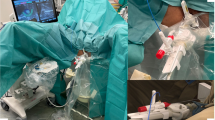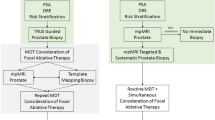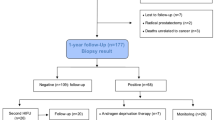Abstract
The efficacy of high-intensity focused ultrasound (HIFU) used for the treatment of localized prostate cancers has been demonstrated over the past decade. We present our early results after HIFU used as a single session in patients with clinically localized prostate cancer. A total of 58 patients were treated using the Ablatherm HIFU device with or without transurethral resection of the prostate (TURP). HIFU failure was defined as the presence of a cancer remnant on repeated biopsies or three consecutive increases in the prostate-specific antigen (PSA) ⩽1.0 ng/ml. The mean follow-up was 14 months (range, 6–21 months). After HIFU treatment, 78% of patients had a decreased PSA level to <0.5 ng/ml within 3 months. The median value of the last PSA was 0.6 ng/ml and the median nadir PSA was 0.2 ng/ml. The success rates of HIFU were 85, 77 and 47% in low-, intermediate- and high-risk groups, respectively. The HIFU failure rate was closely associated with clinical stage, presence of cancer on TURP chips and nadir PSA on univariate analysis. However, the only significant predictor for HIFU failure was the nadir PSA value by multivariate Cox regression analysis. The operation-related complications were minimal. Although both the period and number of patients were limited to evaluate the clinical efficacy, HIFU appears to be a safe and effective treatment option in selected patients with prostate cancer.
This is a preview of subscription content, access via your institution
Access options
Subscribe to this journal
Receive 4 print issues and online access
$259.00 per year
only $64.75 per issue
Buy this article
- Purchase on Springer Link
- Instant access to full article PDF
Prices may be subject to local taxes which are calculated during checkout

Similar content being viewed by others
References
Iselin CE, Robertson JE, Paulson DF . Radical perineal prostatectomy: oncological outcome during a 20-year period. J Urol 1999; 161: 163–168.
Han M, Partin AW, Pound CR, Epstein JI, Walsh PC . Long-term biochemical disease-free and cancer-specific survival following anatomic radical retropubic prostatectomy. The 15-year Johns Hopkins experience. Urol Clin N Am 2001; 28: 555–565.
Augustin H, Hammerer P, Graefen M, Palisaar J, Noldus J, Fernandez S et al. Intraoperative and perioperative morbidity of contemporary radical retropubic prostatectomy in a consecutive series of 1243 patients: results of a single center between 1999 and 2002. Eur Urol 2003; 43: 113–118.
Beerlage HP, Thuroff S, Madersbacher S, Zlotta AR, Aus G, de Reijke TM et al. Current status of minimally invasive treatment options for localized prostate carcinoma. Eur Urol 2000; 37: 2–13.
Kennedy JE, Ter Haar GR, Cranston D . High intensity focused ultrasound: surgery of the future? Br J Radiol 2003; 76: 590–599.
Colombel M, Gelet A . Principles and results of high-intensity focused ultrasound for localized prostate cancer. Prostate Cancer Prostatic Dis 2004; 7: 289–294.
Rebillard X, Gelet A, Davin JL, Soulie M, Prapotnich D, Cathelineau X et al. Transrectal high-intensity focused ultrasound in the treatment of localized prostate cancer. J Endourol 2005; 19: 693–701.
D'Amico AV, Whittington R, Malkowicz SB, Schultz D, Blank K, Broderick GA et al. Biochemical outcome after radical prostatectomy, external beam radiation therapy, or interstitial radiation therapy for clinically localized prostate cancer. JAMA 1998; 280: 969–974.
Consensus statement: guidelines for PSA following radiation therapy. American society for therapeutic radiology and oncology consensus panel. Int J Radiat Oncol Biol Phys 1997; 37: 1035–1041.
Gelet A, Chapelon JY, Bouvier R, Souchon R, Pangaud C, Abdelrahim AF et al. Treatment of prostate cancer with transrectal focused ultrasound: early clinical experience. Eur Urol 1996; 29: 174–183.
Gelet A, Chapelon JY, Bouvier R, Pangaud C, Lasne Y . Local control of prostate cancer by transrectal high intensity focused ultrasound therapy: preliminary results. J Urol 1999; 161: 156–162.
Chaussy CG, Thuroff S . High-intensive focused ultrasound in localized prostate cancer. J Endourol 2000; 14: 293–299.
Gelet A, Chapelon JY, Bouvier R, Rouviere O, Lyonnet D, Dubernard JM . Transrectal high intensity focused ultrasound for the treatment of localized prostate cancer: factors influencing the outcome. Eur Urol 2001; 40: 124–129.
Thuroff S, Chaussy C, Vallancien G, Wieland W, Kiel HJ, Le Duc A et al. High-intensity focused ultrasound and localized prostate cancer: efficacy results from the European multicentric study. J Endourol 2003; 17: 673–677.
Blana A, Walter B, Rogenhofer S, Wieland WF . High-intensity focused ultrasound for the treatment of localized prostate cancer: 5-year experience. Urology 2004; 63: 297–300.
Chaussy C, Thuroff S . The status of high-intensity focused ultrasound in the treatment of localized prostate cancer and the impact of a combined resection. Curr Urol Rep 2003; 4: 248–252.
Vallancien G, Prapotnich D, Cathelineau X, Baumert H, Rozet F . Transrectal focused ultrasound combined with transurethral resection of the prostate for the treatment of localized prostate cancer: feasibility study. J Urol 2004; 171: 2265–2267.
Uchida T, Ohkusa H, Nagata Y, Hyodo T, Satoh T, Irie A . Treatment of localized prostate cancer using high-intensity focused ultrasound. BJU Int 2006; 97: 56–61.
Chen ME, Johnston DA, Tang K, Babaian RJ, Troncoso P . Detailed mapping of prostate carcinoma foci: biopsy strategy implications. Cancer 2000; 89: 1800–1809.
Augustin H, Erbersdobler A, Graefen M, Fernandez S, Palisaar J, Huland H et al. Biochemical recurrence following radical prostatectomy: a comparison between prostate cancers located in different anatomical zones. Prostate 2003; 55: 48–54.
Kavadi VS, Zagars GK, Pollack A . Serum prostate-specific antigen after radiation therapy for clinically localized prostate cancer: prognostic implications. Int J Radiat Oncol Biol Phys 1994; 30: 279–287.
Critz FA, Levinson AK, Williams WH, Holladay CT, Griffin VD, Holladay DA . Prostate specific antigen nadir achieved by men apparently cured of prostate cancer by radiotherapy. J Urol 1999; 161: 1199–1203; discussion 1195–1203.
Acknowledgements
This study was supported by Grant CRS 104502 from the Samsung Medical Center.
Author information
Authors and Affiliations
Corresponding author
Rights and permissions
About this article
Cite this article
Lee, H., Hong, J. & Choi, H. High-intensity focused ultrasound therapy for clinically localized prostate cancer. Prostate Cancer Prostatic Dis 9, 439–443 (2006). https://doi.org/10.1038/sj.pcan.4500901
Received:
Revised:
Accepted:
Published:
Issue Date:
DOI: https://doi.org/10.1038/sj.pcan.4500901
Keywords
This article is cited by
-
Functional micro/nanobubbles for ultrasound medicine and visualizable guidance
Science China Chemistry (2021)
-
Genitourinary Applications of MR-Guided High-Intensity Focused Ultrasound
Current Radiology Reports (2014)
-
Pelvic applications of MR-guided high intensity focused ultrasound
Abdominal Imaging (2013)
-
Robotic High-intensity Focused Ultrasound for Prostate Cancer: What Have We Learned in 15 Years of Clinical Use?
Current Urology Reports (2011)
-
Transrectal high-intensity focused ultrasound (HIFU) treatment of localized prostate cancer: review of technical incidents and morbidity after 5 years of use
Prostate Cancer and Prostatic Diseases (2010)



